|
||||||||||
|
|
||||||||||
|
||||||||||
|
|
||||||||||
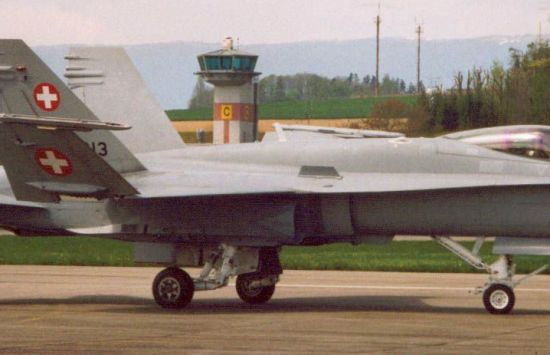
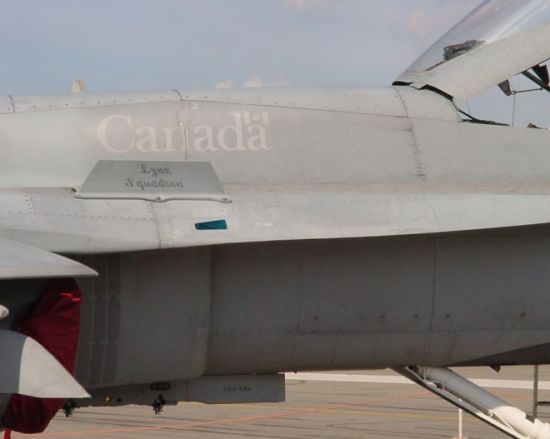
However, you are also correct that some older models of the F-18 are not equipped with such a device. A photo of the very first F-18 is shown below, and you can see that this aircraft does not have a fence.
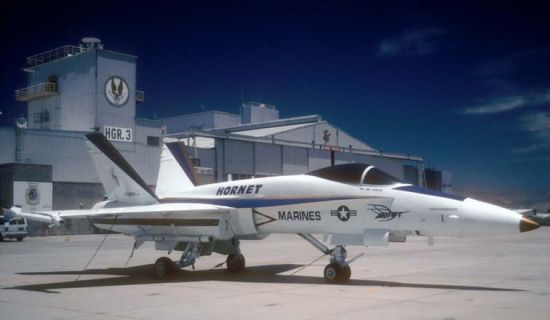
To better understand the purpose of this fence and the leading edge extension, we first need to take a step back and discuss an aerodynamic device called the vortex generator. As described in our earlier article, a vortex is an energetic, swirling mass of air. All aircraft create a type of vortex called a trailing vortex off each wingtip when the plane is in motion. These trailing vortices can be thought of as small tornados that grow larger as they extend behind the plane. A vortex generator is really nothing more than a miniature wing-like device designed specifically to create a vortex. Even though a vortex creates drag, it can also provide advantages that outweigh its negative impact. One such advantage is the ability of a vortex to speed up the flow of air over a wing and allow a plane to reach a higher angle of attack than it would be able to otherwise.
A leading edge extension is designed for the same purpose--to create a strong vortex that increases the stall angle of a wing. The LEX achieves this behavior in the same way trailing vortices are created on a wing, as illustrated below.
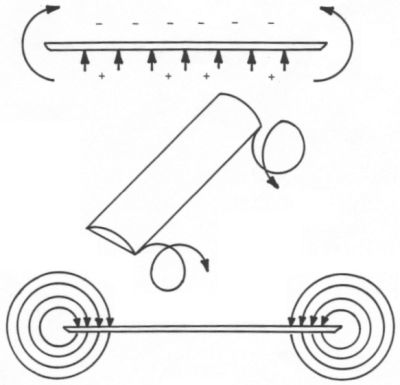
The high pressure air from the lower surface of the LEX rolls around the edge to the lower pressure region on the upper surface of the LEX. This motion induces a rotation on the air flow causing it to roll up into a strong vortex. The strength of the vortex grows as angle of attack increases, and the high-speed vortex helps keep the air flow attached to the surface of the wing beyond the normal stall angle. The effect can be calculated and visualized using computational fluid dynamics (CFD) software as exemplified in the following images.


If conditions are right, the effect can even be seen on a plane in flight. The factors that determine whether the vortices created by an aircraft can become visible are the same as those that determine whether an aircraft produces contrails. Although contrails are typically thought of as being created purely by a plane's engines, the same relationships between temperature and pressure also dictate the formation of "aerodynamic contrails." The following picture illustrates a case in which conditions made the vortices on an F-18 visible. Note the similarities between the vortex structure compared to the CFD illustrations provided above.
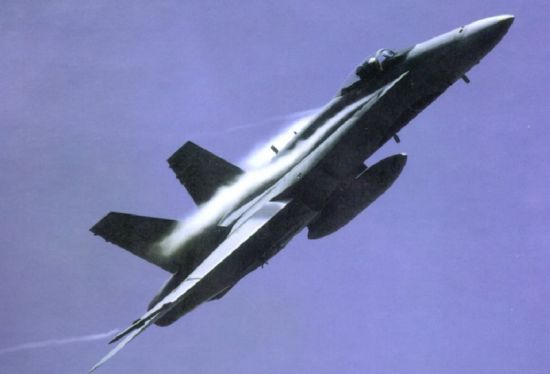
The benefits of these vortices can be appreciated when one realizes that nearly all current military aircraft designs incorporate leading edge extensions and/or canards that perform much the same function. A few examples include the F-16, AV-8B Harrier II, MiG-29, and Su-27.
Unfortunately, these vortices can also create problems, particularly on planes with twin vertical tails like the F-18. Shortly after the F-18 entered service, it was discovered that the vertical tails were suffering from cracks and fatigue. This structural damage limited the first batch of planes to a few hundred flight hours, as opposed to the several thousand flight hours the Navy required for the service life of its aircraft. The cause of the structural cracks was eventually traced back to the LEX vortices impacting on the vertical tails and creating loads the tails weren't designed to handle.
In particular, the problem was due to a phenomenon called vortex bursting. As a vortex travels downstream, it enlarges and becomes weaker. If the rotational velocity of the vortex drops low enough, the increasing pressure within the vortex causes it to lose its tornado-like structure and break apart. This bursting behavior was found to occur just ahead of the F-18 vertical tails. The resulting air flow impinged directly on the tails causing severe buffeting and structural damage. Further worsening the situation was the fact that the frequency of loads induced by vortex bursting just happened to coincide with the first natural frequency of bending in the vertical tail.
NASA conducted extensive investigation of the phenomenon using its F-18 High Alpha Research Vehicle (HARV). During testing, smoke was injected into the LEX vortex making it possible to observe its behavior during flight. The following picture shows the results of one such test. Observe the significant increase in the diameter of the vortex near the vertical tail indicating that the vortex has burst.
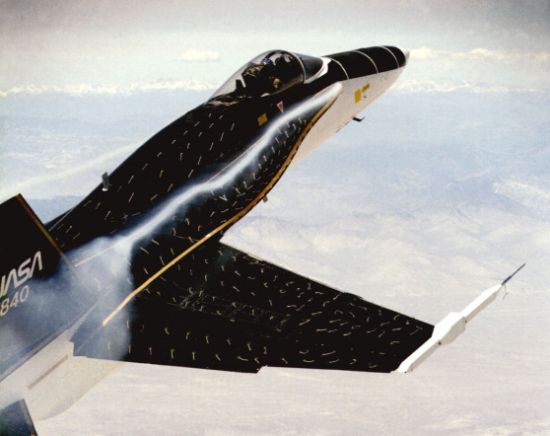
The fatigue and buffet problem was so significant that the Navy grounded its F-18 fleet and refused to take delivery of new production planes until a solution was found. Fearing the entire F-18 program might be cancelled as a result of this deficiency, McDonnell Douglas quickly formed a "tiger team" of engineering experts under the leadership of John Capellupo. The solution they ultimately implemented was the LEX fence described earlier. This fence is essentially another vortex generator itself. The fence creates a second unsteady vortex that interacts with the vortex created by the leading edge extension. This interaction strengthens the rotation of the main vortex so that vortex bursting is eliminated in the vicinity of the vertical tail. The repair was so effective that it not only solved the tail buffet problem but the fence also allows the F-18 to reach even higher angles of attack.
The impact of the LEX fence on the tail buffet problem is illustrated in the following graphs. The upper graph compares the buffet frequencies on the original aircraft without fences observed during wind tunnel tests (WT), flight testing, and using CFD. These five data points appear to form a linear relationship indicating that the buffeting increases as the plane's speed increases.
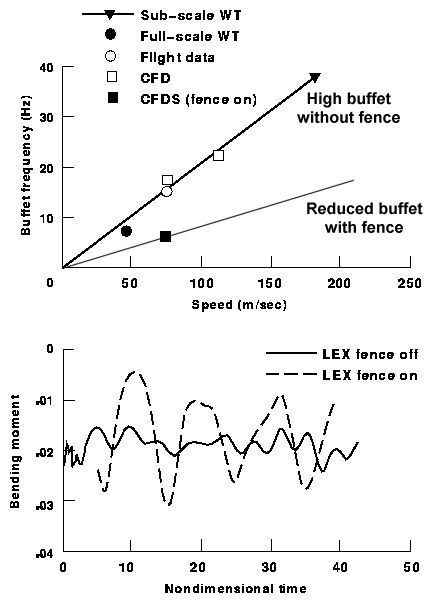
However, the addition of the fence significantly reduces the frequency of the buffet, as indicated by the "fence on" CFD calculation. Furthermore, the second graph plots the bending moment on the tail both with and without the fence. Although the amplitude of the moment is slightly increased by the fence, the frequency is significantly reduced.
In addition to the LEX fence, a second modification was also made to the F-18 to increase the fatigue life of the airframe. Three small L brackets were added to the base of each vertical tail to provide increased structural strength. These brackets can be seen below.
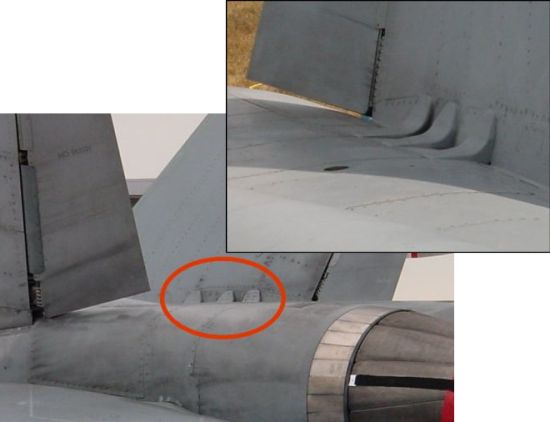
These modifications were made to all subsequent F-18A/B/C/D production aircraft and retrofitted to most planes
already in service. This solution was far simpler and less expensive than the alternative of completely
redesigning the LEX and/or vertical tails. You may also notice that the latest
F-18E/F Super Hornet models are not equipped with LEX fences. Since
the E/F was a totally redesigned variant, McDonnell Douglas engineers could afford to investigate alternative
solutions to further improve the plane's performance. Instead of fences, the F-18E/F makes use of vents located
near the junction of the LEX and main wing. These vents automatically open at high angle of attack allowing air to
flow over the inner wing. This additional air flow interacts with the LEX vortex to delay vortex bursting in much
the same manner as the fence on the older F-18.
- answer by Jeff Scott, 16 May 2004
Related Topics:
What is the U.S. Navy's unofficial name for the F-18E/F Super Hornet? And why is it used?
Why are the stabilizers on planes like the F-18 and F-22 slanted?
Read More Articles:


|
Aircraft | Design | Ask Us | Shop | Search |

|
|
| About Us | Contact Us | Copyright © 1997-2023 | |||
|
|
|||